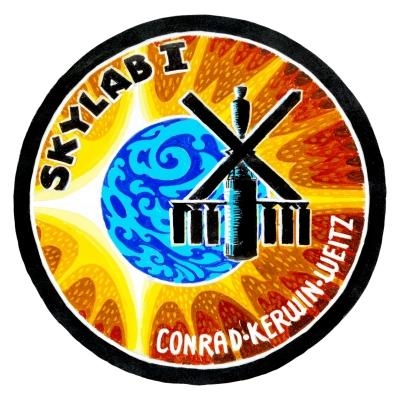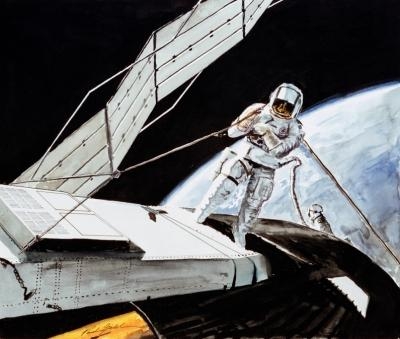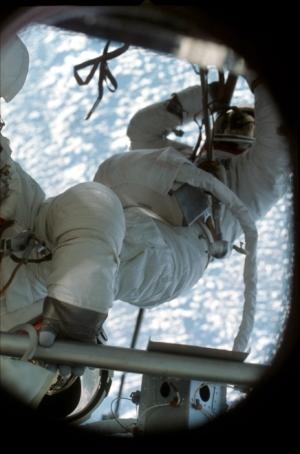It Occurred Not On STS-114 ... But 22 Year Earlier Aboard Skylab
By Wes Oleszewski
“This will be the most dangerous and daring EVA ever attempted!” one TV “journalist” spouted during the July 2005 STS-114 Space Shuttle mission. It was then that astronaut Stephen Robinson was scheduled to ride out on the Shuttle’s Remote Manipulator arm in order to pluck out a couple of pieces of gap-filler that were protruding from between a few of the orbiter’s tiles. This was the first flight after the tragic loss of the Shuttle Columbia and so every move was dramatized by the news media. Indeed Robinson did find the two pieces of gap-filler and simply plucked them out with his gloved fingers. Still the media went on and on about the daring and the danger. In fact, the most daring and dangerous EVA ever attempted was done 22 years earlier by Pete Conrad and Joe Kerwin aboard Skylab. Their mission was to deploy the jammed Solar Array Assembly, (SAS) wing number one and their task was far more daring and far more critical than that of STS-114, yet it was nearly
ignored by the news media.

On the morning of Thursday June 7th, 1973, day 14 of the Skylab 2 mission, Conrad and Kerwin were in the airlock preparing to go EVA and make mankind’s first major repair of a space vehicle in orbit. The hatch was actually a surplus Gemini spacecraft hatch that had been adapted for used on Skylab. After all, it was flight tested, man-rated so re-using it on Skylab would save a lot of time and money and that was a big part of the Skylab mentality; saving nickels and dimes in a multi-billion dollar program. Unfortunately, the process of engineering and adapting a hatch originally designed to conform to a conical hull so that it could later conform to a cylindrical hull ate up a degree of those dimes that had been saved. Still, the hatch was opened and armed with all of the implements needed to execute the “Rusty EVA plan” Conrad and Kerwin emerged from the workshop into the vacuum of space.
Back-up commander Rusty Schweickart had been working long hours in the Neutral Buoyancy Tank at Huntsville to develop a method by which the crew may be able to deploy the jammed SAS wing. With the aid of TV pictures sent down during the initial fly-around of the workshop as well as descriptions from the crew, Schweickart had lead the team on the ground and improvised a method that would eventually lead to the successful of deploying the SAS wing and thus saving the entire Skylab project. Originally, during the initial fly-by of the Skylab 2 Command Service Module, a pair of telephone company limb-loppers were supposed to be used by Skylab 2 pilot Paul Weitz to cut completely through the aluminum strap that was thought to be holding the SAS wing down. But his angle to the strap negated that method of using the loppers. Now Schweickart came up with another use for the limb-loppers; they would make a good anchor. The plan was for Kerwin to extend a long pole with the limb-loppers secured to the end
out as far as the strap. Next he would use the jaws of the loppers to bite into the strap cutting it about half way through and thus anchor the far end of the pole. Conrad would then move hand-over-hand out along the pole and secure a line onto the far end of the SAS wing. Then he would return along the line and he and Kerwin would move under the line and, with their feet on the workshop, both astronauts would stand up and exert as much pressure as they could on the line. It was felt that such leverage would break the SAS wing loose and allow its solar panels to deploy.

Kerwin got the pole extended without any problem, but getting the jaws of the limb-loppers onto the strap was proving to be impossible. Throughout an entire day pass around the Earth, Kerwin struggled with the 20 foot long pole, but without any foot restraints, every time he moved the pole his body simply torqued away in the opposite direction. Conrad tried to hold onto Kerwin’s ankles and stabilize him, but it was no use. Frustrated, the two men grunted and cussed as the Skylab went in and out of the range of ground stations.
Back on Earth I had was allowed to again take the day off of school. Frankly, in my “school” most of the kids were kept home during the final few days of the school year because that was when most of disturbances took place- so staying home to monitor this critical EVA was no problem for me. What was a problem was the actual “monitoring” of the EVA itself. None of the television networks carried anything concerning the event. After all, there was no television being sent down showing the activity- so why bother to interrupt the game shows and soap operas? Once again, the only outlet for those of us outside of NASA to keep track of this critical and dangerous EVA was the top and bottom of the hour news broadcasts on the AM radio. My local station, 1400 WSAM, had NBC’s veteran spaceflight reporter Jay Barbree making the twice hourly reports. Mixed in with Watergate and other assorted news, Jay’s reports were about 20 seconds long and often included a sound bite with
the voices of the astronauts. His name spoken by the news anchor Wilson Hall meant that space stuff was soon to be heard. As the Skylab made that day pass, Jay’s clip had Conrad and Kerwin in an obviously frustrating situation and not doing well.
The exchange went like this:
Conrad: "Joe, you got to have it tethered, and it'll slide out let it slide out, it can slide out."
Kerwin: "It's not tethered to what?"
Conrad: "The pole. Let me get it in front of the pole…"
Kerwin: "What are you going to tether the pole to? Oh, yourself, huh?"
Conrad: "No. Now you…"
Kerwin: "Oh! The BET!"
Conrad (in frustration): "I just… No, damn it! I'll tell you what I wanna do. Back…"
Kerwin: "What is that tether you’ve got on there?"
Conrad (with a resigned sigh): "That's the pole tether. Now, if you just stay with me a minute. Come on back with pole, I'll tell you what were going to do we’re going to get it in the right configuration."
Kerwin: "We were in the right configuration…"
Conrad: "No we weren't. We were too short. We couldn't slide your pole back. See? Now the tether will go as far up the pole if you want to. You follow me?"
Kerwin: "Whew.”

In keeping with the media’s coverage of Skylab, that little, frustrated exchange between the two astronauts was repeatedly played through the entire day- even long after the crew had successfully completed their EVA and later it was played the following day.
Kerwin’s biggest problem was getting his feet anchored. He had told Schweickart that the problem was not a hand stability problem, but a foot stability problem. Then as the station was out of communication range, the two astronauts spotted a protruding “U” bolt on the surface of the workshop. They had some extra tethers and quickly cooked up a plan to solve the foot stability problem. They ran the tether through a loop on the front of Kerwin’s suit, pulled it tight and then when he stood up he had a three-point stance. In a matter of minutes he had the lopper anchored to the aluminum strap.
When next the crew came into range of a communications station, Conrad and Kerwin were still wrestling with umbilicals, but had the jaws of the limb lopper in place. That brief period of radio contact had them tangled in the umbilicals and being heavily coached by Rusty Schweickart in Mission Control. Paul Weitz was asking if they wanted him to come out and help. Conrad, however, quickly belayed that idea and things did not look good as the crew passed out of range of the Vanguard tracking ship.
It would be one hour and three minutes before the Skylab would again pass into communications range at Goldstone. The workshop was in its 347th orbit and in Houston Schweickart and the engineers could only sit and wait. Conrad and Kerwin, however, were very busy. After getting their umbilicals straightened out, Kerwin steadied the pole while Conrad crawled out along it as far as he could. He fastened the line to the SAS wing where it would do the most good and then came back. Kerwin then fastened the other end to the workshop. As Conrad headed back, the limb-lopper jaws decided to cut all the way through the strap and the huge SAS wing started to rise up with Conrad aboard! The wing, however, stopped at about 18 to 20 degrees up. A “snubber” on the hinge needed to be physically broken in order to fully deploy the wing. So Conrad returned to the area near Kerwin and prepared for the final maneuver. Now both astronauts ducked under the line and with it over their shoulders they stood up and
applied as much force as they could. Kerwin says that although there was no sound, he felt a sense of release that would normally be associated with “a loud crack.” The SAS wing broke loose, the line let go and the two astronauts, who had been pushing with all of their strength against the workshop with their feet and the line with their shoulders were shot into space “Ass over tea kettle,” as Kerwin puts it. Conrad said it was like being shot out of a bow and arrow. Of course both men had umbilicals secured to the station, so they did not go far.

When each astronaut regained their senses and looked back at the workshop, they saw the SAS wing deployed and the solar panels coming out. This was indeed the most daring and dangerous EVA ever attempted and they had succeeded in a glorious manner.
As the workshop came into range of the Goldstone station, telemetry quickly showed the crew’s success. Power levels for SAS wing #1 were rapidly climbing. As soon as voice was enabled, the two crewmen were heard chattering about the open SAS wing. Conrad reported, "All right. I'll tell you where we are. We've got the wing out and locked, the outboard panel and the middle panel are about out the same amount, and the third one is not quite. Now, Joe, I think before you come in, you better take a look up there and make sure that third one is clear of all the debris."
Communications were regained at one minute after the hour and in just minutes the ears of the space news media picked up the success. With my ears glued to the radio and with my tape recorder at the ready, I had been recording every news break and every shred of Skylab news all day. The word came first from Wilson Hall who was the NBC radio news anchor. He simply said, “There’s good news from space.” Then he tossed to Jay Barbree who came on and happily reported, “In a daring difficult spacewalk man has proven that he can repair and save a billion dollar spaceship in earth orbit!” I let out a “Wahoo!” that ended up on my tape. I knew what this meant to the program as well as to the future, yet I was among the few who actually realized the weight of the situation and what had been involved in the repair. I don’t know how many other kids of my age had been following the EVA that day- but I do know that Jay Barbree and NBC radio had been the only source
filling me in on that historic event. I never imagined that I may one day meet Jay, nor that he would ever know about how I hung on all of his reports and my “Wahoo” at this report. Yet, 39 years later, my college pal Jim Banke, a long-time spaceflight journalist, had his own spaceflight radio talk-show, appropriately called “Space Talking,” on the Florida Space Coast. When I found out that one of Jim’s guests was going to be Jay Barbree, I sent Jim the “Wahoo” clip with Jay’s report from four decades earlier; Jay was highly amused. Just a few weeks later, I was at KSC covering a launch and Jay came strolling into the press site. I walked over and asked him if he remembered that Skylab sound clip of that 15-year-old kid that was played on Jim’s show. He smiled and said, “And I’ll bet you were that kid,” it was a delightful moment and we both had a good laugh. Life goes in unexpected directions.
Note: This text is a segment from a series of books being written by Wes Oleszewski titled “Growing up with Spaceflight” that will be released on Kindle beginning in 2014.
(Images provided by NASA)
 Senator Pushes FAA to Accelerate Rocket Launch Licensing
Senator Pushes FAA to Accelerate Rocket Launch Licensing Classic Aero-TV: RJ Gritter - Part of Aviations Bright New Future
Classic Aero-TV: RJ Gritter - Part of Aviations Bright New Future Aero-FAQ: Dave Juwel's Aviation Marketing Stories -- ITBOA BNITBOB
Aero-FAQ: Dave Juwel's Aviation Marketing Stories -- ITBOA BNITBOB ANN's Daily Aero-Linx (10.27.24)
ANN's Daily Aero-Linx (10.27.24) ANN's Daily Aero-Term (10.27.24): Clearance Void If Not Off By (Time)
ANN's Daily Aero-Term (10.27.24): Clearance Void If Not Off By (Time)






